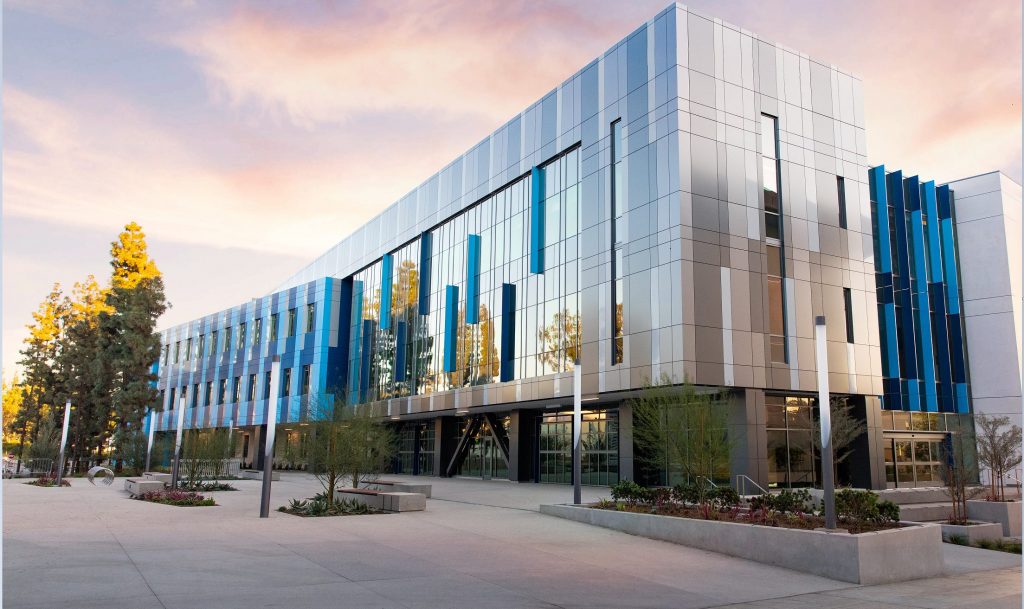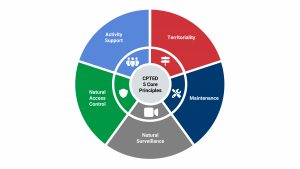
CPTED was created in the 1970s by criminologist C. Ray Jeffrey and architect Oscar Newman as a response to the negative impact of urban physical construction initiatives and strategies on the social structure required for self-policing, which resulted in increased crime rates. The foundation of this self-policing process rests on the belief that facility stakeholders can actively prevent crime through an environment’s physical design and architecture. These design features can include fencing, bollards, and landscaping placement to create clear lines of separation between areas. The human and physical resources that architects, security experts, and other stakeholders utilize in an environment can have a long-lasting impact on mitigating crime.
Principles of CPTED

The five core principles of CPTED are:
• Natural surveillance
• Natural access control
• Territoriality
• Activity support
• Maintenance
Natural Surveillance
Natural surveillance involves placing architectural features, activities, and people in spaces to maximize visibility. This increased visibility also heightens the perception of being watched and monitored, thus deterring criminals from engaging in illegal activities. Natural surveillance encompasses:
• Lighting placement and maintenance for visibility
• Landscaping uniformity, height, and shape to reduce hiding places for intruders
• Fencing height and clear visibility through the fence
• Window locations to increase natural surveillance
Natural Access Control
Access control is a security system that manages the entry and movement of individuals within a space or facility. It assists in channeling people into, alongside, or out of areas and deterring entry through designated entrances and exits, fencing, landscaping, and lighting placement. Controlling and regulating the flow of people within a space can significantly impact crime prevention.
Examples of access control include:
• Designated ingress and egress points
• Shared areas near entrances that allow more surveillance
• Visible hallways and foyer entrances
Territoriality
Territoriality discourages crime by clearly marking the boundaries of an area, signaling to potential criminals that they are entering a controlled and monitored area and that occupants are using the space for specific purposes. This awareness creates a psychological deterrent for both occupants of the space and potential intruders.
Examples of territoriality include:
• Placement of balconies over streets to add to surveillance
• Distinct transitions between private, semi-private, and public areas
– Lines of demarcation for open spaces, such as retail areas and parks, as well as for private-use and residential areas — this is common with mixed-use facilities
– Identifiable, separate avenues of ingress and egress to control the movement of people
– Adequate signage that designates public vs. private spaces
Activity Support
Activity support promotes authorized, legitimate activities within a public space, which helps the community understands an area’s intended use. Such activities also engage users with the area, creating a sense of ownership and investment. This active participation helps to deter criminal behavior, resulting in a safer environment for all.
Examples of activity support include:
• Promoting the proper behaviors for visiting a retail space, such as shopping, while discouraging actions, such as loitering
• Having a physical design layout that promotes an open field of view and surveillance from the public to remediate criminal acts
Maintenance
Caring for and maintaining an area for its intended purpose is vital; a lack of care indicates a loss of control and is a sign of tolerance for disorder. For example, the “broken windows theory,” formulated by James Q. Wilson and George Kelling in 1982, suggests that damaged facilities, such as broken windows, can attract criminal behaviors.
Examples of lack of maintenance include:
• Broken windows
• Overgrown shrubbery or landscaping
• Inadequate or unmaintained fencing
• Worn or Malfunctioning locks
CPTED Uses: When is it appropriate?
When developing a new physical site or facility, conducting an annual security-risk survey, or assessing a physical space, all stakeholders should consider CPTED. Security professionals can apply Crime Prevention Through Environmental Design to any facility, including hospitality, retail, mixed-use, residential, commercial, healthcare, government, and other settings, while also meeting each project’s unique requirements.
Additionally, CPTED is now statutorily required for new builds in some jurisdictions worldwide.
CPTED Effectiveness
CPTED has demonstrated its effectiveness in various settings. Implementing CPTED principles has reduced crime rates; based on a data-driven, analytical assessment, CPTED had a positive impact on mitigating crime by up to 84% (Casteel and Peek-Asa, 2000). Additionally, the strategy has increased community cohesion and improved the quality of life in numerous neighborhoods. CPTED’s focus on proactive measures and prevention also aligns with modern approaches to law enforcement, shifting the emphasis from solely reactive responses to proactive crime reduction strategies.
TEC CPTED Services
Our TEC security experts specialize in Crime Prevention Through Environmental Design. Whether you are developing a new site or facility or seeking to assess and improve the safety of your existing space, our custom-tailored CPTED solutions will provide you with the peace of mind you deserve.
TEC’s CPTED-related services include:
• Security-Risk Surveys
• Reports
• Determining the next steps
CPTED Security-Risk Survey
- Identifies and prioritizes assets, including people and property, that need to be protected
- Identifies vulnerabilities within the enterprise’s built and natural environments
- Identifies current and probable future threats and the risks associated with these threats
CPTED Report
• Summarizes findings of the security-risk survey
• Recommends improvements that reduce risks and threats to people, operations, and facilities
Next Steps
• For new construction, TEC’s CPTED security professionals will work with all relevant stakeholders, such as construction professionals, property managers, law enforcement, and community leaders, to ensure the physical location is designed to mitigate crime
• For an existing space, our security experts will work with property management and their pertinent stakeholders by recommending improvements to the physical environment to align with CPTED objectives
 CPTED questions? Please contact Daniel Loo at dloo@telgian.com or 480-250-9127.
CPTED questions? Please contact Daniel Loo at dloo@telgian.com or 480-250-9127.
About Telgian Engineering & Consulting, LLC
Leading the industry since 1985, TEC is a full-service global engineering and risk mitigation consulting firm specializing in complex, multi-discipline public and private sector projects. TEC provides professional services related to the protection of people, property, information, and organizational mission against preventable losses. Solutions include strategic/enterprise risk management, fire protection engineering, industrial security, environmental health and safety, emergency management, operations continuity consulting, and construction administration services. TEC professionals are dedicated to delivering value through effective protection solutions that meet today’s unique risk challenges. Contact us for immediate support at 1.302.300.1400 or tec@telgian.com.
